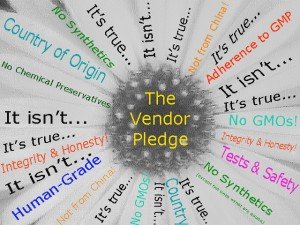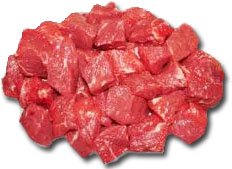26th Jul 2011
What about Those Pledges Some Companies are so Proud of?
There is a new marketing gimmick going around. The vendor pledge. Some health food stores state that they collect vendor pledges to assure high standards and integrity of their ingredients and products. And now, even some pet food companies have announced with great flourish (using paid press releases from PR agencies, friendly or associated blogs, their own websites, etc.) that they now require their vendors to supply them with pledges for each ingredient they use. The ingredients need to be GMO-free, cannot be sourced from China, the animals need to be raised and processed in the best possible ways, etc.
This sounds great. So what’s the problem, and why am I writing about it?
The answer is simple: None of these so-called ‘vendor pledges’ can be verified. Many comforting and reassuring words are flying fast and furious, but there’s no independent party that can verify all these great-sounding words. It’s as if a company released favorable results from a poll they conducted themselves. Now, honestly, how much faith would you place in such results?
Why advertise vendor pledges?
That’s an easy one: profit, pure and simple.
What are meaningful alternatives to such pledges?
 The most meaningful alternatives are third party-enforced certificates.
The most meaningful alternatives are third party-enforced certificates.
Two examples are:
1) a USDA organic certificate; and
2) a non-GMO statement that’s also legally binding (they are required for any certified organic pet food that contains non-certified organic ingredients such as citric acid).
An additional alternative is a statement from the Humane Society that declares that a particular poultry farmer/processor is far above industry standards in respect to the humane treatment of animals (I might also mention here that, at Onesta Organics, we use such a farmer’s products routinely). As in the case of the first two examples, this declaration can be verified by a third party.
The nice thing about the USDA organic certificate is that any company (including Onesta Organics) that receives such certification is inspected at least once yearly (food factories for human consumption foods are generally inspected less than once per decade), and all ingredient choices must be shared with a USDA-accredited certification agent. This agent knows where the ingredient comes from, if it is human-grade, free of pesticides, antibiotics, and other synthetics, etc.
In the case of a vendor pledge, all you have to go on is the word of a given company and nothing more. The sad truth is that vendor pledges can’t be verified and aren’t based on any enforced standards. With an enforced certificate, at the very least you have the assurance that any false claims have serious legal consequences.
So, when you’re faced with a choice between a vendor pledge and a certificate from the USDA, a statement from the Humane Society, or any other entity requiring third-party oversight, you now know which one of the two is trustworthy!
There is a new marketing gimmick going around. The vendor pledge. Some health food stores state that they collect vendor pledges to assure high standards and integrity of their ingredients and products. And now, even some pet food companies have announced with great flourish (using paid press releases from PR agencies, friendly or associated blogs, their own websites, etc.) that they now require their vendors to supply them with pledges for each ingredient they use. The ingredients need to be GMO-free, cannot be sourced from China, the animals need to be raised and processed in the best possible ways, etc.
This sounds great. So what’s the problem, and why am I writing about it?
The answer is simple: None of these so-called ‘vendor pledges’ can be verified. Many comforting and reassuring words are flying fast and furious, but there’s no independent party that can verify all these great-sounding words. It’s as if a company released favorable results from a poll they conducted themselves. Now, honestly, how much faith would you place in such results?
Why advertise vendor pledges?
That’s an easy one: profit, pure and simple.
What are meaningful alternatives to such pledges?
 The most meaningful alternatives are third party-enforced certificates.
The most meaningful alternatives are third party-enforced certificates.
Two examples are:
1) a USDA organic certificate; and
2) a non-GMO statement that’s also legally binding (they are required for any certified organic pet food that contains non-certified organic ingredients such as citric acid).
An additional alternative is a statement from the Humane Society that declares that a particular poultry farmer/processor is far above industry standards in respect to the humane treatment of animals (I might also mention here that, at Onesta Organics, we use such a farmer’s products routinely). As in the case of the first two examples, this declaration can be verified by a third party.
The nice thing about the USDA organic certificate is that any company (including Onesta Organics) that receives such certification is inspected at least once yearly (food factories for human consumption foods are generally inspected less than once per decade), and all ingredient choices must be shared with a USDA-accredited certification agent. This agent knows where the ingredient comes from, if it is human-grade, free of pesticides, antibiotics, and other synthetics, etc.
In the case of a vendor pledge, all you have to go on is the word of a given company and nothing more. The sad truth is that vendor pledges can’t be verified and aren’t based on any enforced standards. With an enforced certificate, at the very least you have the assurance that any false claims have serious legal consequences.
So, when you’re faced with a choice between a vendor pledge and a certificate from the USDA, a statement from the Humane Society, or any other entity requiring third-party oversight, you now know which one of the two is trustworthy!
 Posted by Heidi Junger, PhD under
Posted by Heidi Junger, PhD under  Organic Pet Food Standards, Regulations
Organic Pet Food Standards, Regulations  Comments Off
Comments Off





